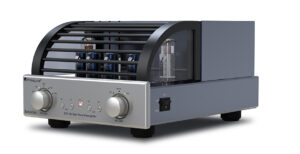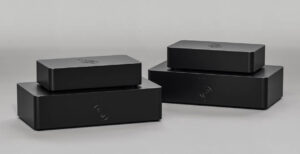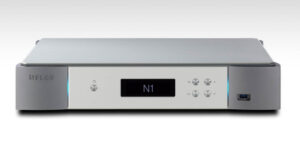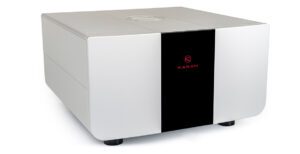
Ever-presents are a rarity in audio systems – and are almost unheard of in those systems used by reviewers. Yet ever since I graduated from an LP12 in the early ‘80s, first VPI’s turntables and then their tonearms have been a constant presence in my life, starting with the HW-19 Mk III and progressing through a range of TNT and then Classic models, right up to the present day. With three systems running 24/7, two of them feature VPIs: a Classic 4 mounting the (inevitable) 12” JMW tonearm and, the subject of this review, the Avenger. Looking at the startling ’Black Star’ aesthetics it would be easy to assume that this, the base model in the company’s three-legged flagship series marks a serious change in direction, but in fact the Avenger represents the next logical step in what has been an utterly logical and linear developmental path.
The key to VPIs line (and their longevity) is the clarity of thought behind it and the elegant simplicity of its execution. My original HW-19 is not only still going strong, but it has also been periodically upgraded over the years, the latest external power supply being the most recent addition. The fact that the power supply introduced for the Avenger interfaces seamlessly with a model that’s almost 40-years young should give both potential customers and competing manufacturers serious pause for thought. That straightforward practicality is the bedrock on which the VPI turntables have been built and on which their consistent and consistently impressive performance rests, the living embodiment of incremental advance and “If it ain’t broke, don’t fix it.” It may not be immediately apparent, but the thinking behind and design of the Avenger can be traced directly back to VPI’s earliest products.

One of the company’s earliest designs was a plinth system for Japanese direct drive turntables, featuring a laminated, suspended chassis. Having then built a belt-driven platter to mount in that plinth, it wasn’t long before the motor doing the driving was offered in a separate, mass-loaded standalone housing. Combine those elements with the PEEK thrust pad, inverted bearing and decoupled (as opposed to sprung) feet first introduced with later TNT models and you have the central helix of the Avenger’s DNA. Not surprisingly, the actual execution of the various parts has evolved, being steadily refined over the years, but the building blocks are all distinctly familiar.
Starting with the chassis, the 45mm thick aluminium/acrylic laminated material was first seen in the TNT HRX. Likewise, the conical Delrin feet, topped with threaded industrial isolation inserts that allow both decoupling from external vibrational energy and easy levelling of the deck. Although the original versions stood on three small ball-bearings to ensure stable, point contact, the minimal interface allowed them to ‘walk’ over time, and current versions now rest on an embedded O-ring. The platter, its inverted bearing and the cylindrical motor housing have all come directly from the late model TNTs and that in turn makes the Avenger compatible with all of the TNT accessories, from the external power supplies (although the latest model power supply was introduced alongside the Avenger) to the peripheral record clamp, the screw down centre clamp and the record weight.
By now you might be wondering if the Avenger is just a model re-fresh, an exercise in re-styling an existing product to respond to the vagaries of fashion? But if the big difference between the Avenger and the last TNT is the shape of the chassis and the shift to three legs, the motivation that drove the move was anything but stylistic. Whilst the TNTs might not have been everybody’s cup of Joe, the one thing that nobody could argue with was their size: they were not small turntables, the external motor drive, with or without additional flywheel(s) and the need to accommodate 12” tonearms made for a beast of a record player. So much so that a small industry sprang up dedicated to delivering racks and platforms capable of supporting the monster, while it was practical reservations that drove the development of (reversion to) the Classic models. Yet despite its extensive footprint, the one thing that the TNT never cracked was accommodating two tonearms. Well, the times they are a changin’ and if the size of record players has expanded at the same rate as Western waistlines, the ability to support more than one tonearm has become pretty much mandatory on any serious deck. Ironically, VPI was one of the first companies to take the need to mount multiple cartridges seriously. It has long offered its own solution to the issue of mono or 78 replay in the shape of the JMW tonearm, with its interchangeable arm-tops, a system so effective and easy to use that it has become essential to my reviewing activities. But audiophiles are nothing if not excessive personalities so why have one arm that does the job when you could have two?
The three-legged layout of the Avenger, with the outboard location of its support towers solves the problem. With each tower topped off with a stainless steel cylinder, the armboards simply clamp around the top of the most convenient leg, while the ability to rotate the standard armboard allows the user to adjust arm mounting height and P2S dimensions to accommodate any design from 9” to 14”. With three legs that means you can mount three tonearms (although you might have to juggle their order around the platter to accommodate different effective lengths) while the symmetrical layout of he chassis means that it can be orientated and the motor placed for maximum convenience – a consideration that might not seem important until you remember that the pivot point of any tonearm mounted on this deck is a moveable feast. Being able to rotate things so that your main arm falls neatly to hand is not to be sniffed at – although it does raise one significant flag. If the TNT was demanding when it came to lateral space, the potential front to back depth of the Avenger means that if you aren’t careful its rear leg might end up in a different time zone! With a possible maximum depth of 46cm there are a lot of racks that will struggle to accommodate it. Twisting the deck slightly will reduce that dimension, but it will also affect the location of the tonearm(s), so it’s worth figuring out where or what you are going to place the deck on before you get it home…
Despite the fact that I use the JMW tonearm on the Avenger (the 3D printed 12” version) those extra arm-mounts are too good an opportunity to miss. I’ve run the Kuzma 4Point and 313 with considerable success but ultimately, I settled on the Timestep T612 as the perfect partner – both sonically and temperamentally. With its curved titanium arm-tube, detachable headshell and 12” effective length, this is an arm that harks back to the likes of the Fidelity Research tonearms and the FR-66S in particular. Okay, the titanium tube brings a slightly different (and arguably more linear) character to the arm, as well as a lower effective mass, but the easy musical flow, dynamic range, presence and spatial coherence that characterised the FR arms is all present and correct. As befits a modern update, it offers greater resolution and extension at the top end, but its easy-going musicality and detachable headshell are right up VPI founder Harry Weisfeld’s alley. It makes for a handsome, high-value combination – and that’s up his alley too.

As I already mentioned, the Avenger sits at the base of a modular product line that ultimately tops out with the stacked-up, limited edition, multi-level, direct-drive Vantage. Owners can upgrade via rim-drive and magnetically de-coupled platter options, additional plinth levels and more sophisticated feet – all with minimal redundancy. At VPI, the notion of a long (and adaptable/upgradable) product life is taken seriously and the Avenger is no exception to that rule. That brings a lot of added value to a VPI purchase, but the value doesn’t stop there. At £11,000 including the JMW 3D12 tonearm and weighing in at a shade under 31kg, that’s an awful lot of turntable for the money – physically and sonically. In material terms it doesn’t use a single piece of compressed wood dust, while traditional production methods involving acrylic, aluminium and steel alloys mix it with 3D printed components.
That sense of mechanical integrity and solid engineering carries over into the Avenger’s musical presentation. When I reviewed the original TNT I described it as “meaty, beaty, big and bouncy” a phrase that encapsulated its sheer presence and musical enthusiasm, impressive dynamic range and acoustic scale. In a world inhabited by lightweight suspended decks, with their limited bandwidth and dynamics, shrunken sound stages and two dimensional imaging, the big VPI wasn’t so much a breath of fresh air as a tornado of musical intent, momentum and entertainment. Just like an overly energetic St Bernard puppy, the boundless energy of those early decks could occasionally lead them into trouble, but over the years that unruly streak has been trained out of the breed, each subsequent model better behaved and more refined than the last. The Avenger retains that crucial grasp of musical substance and projection, dimensionality and scale, easy dynamics and musical momentum, but keeps it all on a tighter rein. Along with greater resolution and a calmer stability, that planted quality brings a convincing sense of musical, dynamic and spatial coherence. All grown up and articulate, the Avenger is the most accomplished TNT by far.
You don’t need a crystal ball to anticipate the power and aplomb with which the Avenger delivers multi-facetted orchestral masterworks, from Danil Trifonov’s recent Rachmaninov, in which he off-sets Nézet-Séguin’s precision with playing that’s vivacious and stentorian by turns, to Previn’s Swan Lake, where even the most familiar passages are invested with a crisp and purposeful fascination. But it’s in the realm of smaller, more intimate works that this ‘table really gets to strut its stuff. Voices have always been central to the VPI’s performance envelope and the Avenger maintains and even extends that tradition, bringing a natural presence, intimacy and expressive intensity to vocals. When Vampire Weekend play ‘Oxford Comma’ you are left in no doubt as to Ezra Koenig’s utter contempt for the grammatical carbuncle (although somewhat ironically, it’s the Brit’s that get the blame, when we abandoned the absurdity years ago!).
But perhaps the Avenger’s polished poise is best exemplified by Sol Gabetta’s vivid Cello transcription of Vivaldi’s ‘Winter’ from the Four Seasons. Her instrument is placed front and centre, directly in the path of the high-energy, high tempo playing of Sonatori de La Gioiosa Marca, their incisive, insistent bowing laying down a serious challenge to which the Cello responds with a virtuoso display of driven precision and energy. Impressive enough on most turntables, on the Avenger Gabetta’s playing takes on an almost physical presence, such is the concentrated vigour that the turntable drags from the groove. But where earlier iterations of the TNT ingredients might have gone over the top, this ‘table releases the energy but with a grip and swagger to match the incredible display of musical technique. The Avenger ensures that she’s not just here, she’s here with some serious attitude and the ability to back it up.

Of course, with any upgradable product you are dealing with a kit of parts and choosing which to include is crucial. For me the Analogue Power Supply is a must while the Peripheral Clamp is definitely a “nice to have”. But the beauty of the inherent simplicity that those inveterate audio tinkerers, the Weisfeld clan have built into all of their products and which continues today, is that they also lend themselves to third-party mods. If you opt for the JMW arm, then the Soundsmith Counter Intuitive set-up accessory is a God-send, while substituting SortKones for the existing feet on the turntable will generate a significant hike in resolution, dynamic range and discrimination (and a smaller hike in the height, necessitating a bit of creativity under the motor pod). An infectiously musical performer straight out of the box, the Avenger lends itself to further upgrades or modifications with the passing of the years. With many vinyl lovers looking to buy their “last turntable”, VPI is offering you the chance to stuff down a monster slice of gateau while still having some left over for later. It’s been a long, long time since I was without a VPI turntable in the house. The arrival of the musically impressive Avenger ensures that won’t be changing anytime soon.
TECHNICAL SPECIFICATIONS
- Type: Belt-drive turntable (with rim-drive upgrade option)
- Motor: AC Synchronous
- Speeds: 33/45 RPM (user adjustable with optional Analogue Power Supply)
- Bearing: Large diameter, inverted, PEEK thrust-pad
- Platter: One-piece aluminium
- Dimensions (W×D): Footprint 560 × 460mm (22” × 18”)
External dimensions increase with number and type of tonearms fitted - Weight: 30.84kg (68lbs)
- Prices: Avenger/JMW3D12 £11,000
Peripheral Ring Clamp £1,100
Analogue Power Supply £1,200
Manufacturer: VPI Industries Inc.
URL: vpiindustries.com
UK Distributor: Renaissance Audio
Tel: +44(0)131 555 3922
By Roy Gregory
More articles from this authorRead Next From Review
See all
PrimaLuna EVO 100 phono preamplifier
- Apr 22, 2024

Reiki Audio SuperSwitch Master Pro + Servant Pro
- Mar 27, 2024

Melco Audio N1-S38 music server
- Mar 27, 2024











